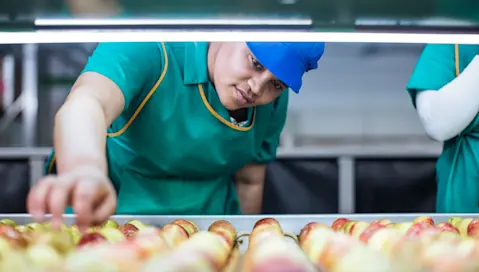4 Steps to Create Excellent Food Product Traceability Procedures
4 Steps to Create Excellent Food Product Traceability Procedures
4 Steps to Create Excellent Food Product Traceability Procedures
22 Mars 2022
Jack Payne
The importance of traceability is fairly well understood in today’s food and beverage industry. Business leaders are well aware how vital this consideration is to their success, with respondents to IDC’s Global Food and Beverage Industry Trends and Strategic Insights whitepaper commissioned by Aptean naming the combined subjects of food safety and traceability as their primary focus for risk mitigation.
What’s more, food and beverage companies know the risks they run should their traceability measures fall short—the often-quoted figure of product recalls costing an average of $10 million demonstrates the financial consequences, and the potential damage to brand reputation can be just as costly. All told, the increased focus on this area has the food traceability market expected to reach $18.5 billion by 2023.
These statistics and trends further underscore how vital traceability is, but what they do not establish is how food and beverage companies should design their food product traceability procedures and carry them out. Read our blog specifically on Traceability Challenges for Sauces and Dressings Manufacturers.
The four following sections should give you a clearer picture of how to go about this process.
1. Lay the Foundation with a Digital Platform
The first step in establishing your traceability procedures for food safety will be to find the right system to use. Paper-based means don’t cut it in today’s day and age, so you’ll need to look for a fully digital solution—and it’s critical that whichever you select is tailored to food and beverage businesses like yours.
The gold standard on this front is enterprise resource planning (ERP) software. These comprehensive platforms serve a number of different key functions, not the least of which is to effectively implement a robust traceability plan.
Here are the key advantages of using an ERP for traceability:
Ability to define any number of fields for different kinds of raw material and finished product information, including lot numbers, country of origin, variety, quantity, expiration date and more
Integrations with smart devices, including barcode scanners and IoT-enabled equipment
Real-time updates based on the latest data
Ease of access, with an intuitive user interface and—in the case of cloud deployments—mobile access
While this initial measure may require significant investments of time, effort and funds from the exploratory research stages through the go-live date for your system, it’s crucial that you have the right technology in place if you really want to master traceability.
2. Collaborate with Supply Chain Partners
As the next step in the process, you’ll need to communicate with your suppliers and clients to make sure that their approaches to traceability will help all parties involved achieve full end-to-end tracking of ingredients and goods. After all, your organization won’t be able to meet your goals in this important matter without the full cooperation of your business partners.
While in the past it might have been sufficient to track your materials and finished goods just one step backward and one step forward in the supply chain, that is no longer the case—you need complete visibility, from the original supplier of your materials all the way to the retail and foodservice outlets you serve.
So that no pertinent details are left out, all critical tracking points (CTPs) are covered and information is shared in a timely manner, make sure you discuss and agree upon each of the following with your partners:
What ingredient and product data needs to be captured (consult the list of examples above and aim for a comprehensive set of variables to track)
When information should be collected (including all CTPs, upon receipt and departure, etc.)
How data will be shared between entities (ideally a fully digital format that imports to your ERP)
How frequently the information will be relayed (immediate, real-time updates are optimal)
The conversations that you have with suppliers and clients at this stage will be vital to ensuring the integrity of your data and facilitating product recalls and withdrawals when necessary.
projected valuation of the food traceability market by 2023
3. Create an Internal Recall Team and Recall Plan
Speaking of product recalls, your company will clearly be aiming to avoid these issues as much as possible by employing good traceability procedures for food safety, but we must recognize that even the best-laid plans can go awry. In the event of an emergency, you’ll need to be prepared with team members to call upon for a swift and smooth execution and a clear list of steps to follow.
For your recall team, you’ll want to include factory floor staff, an operations manager, representatives from your communications or marketing department and potentially some of the higher-level decision-makers at your business. They should immediately set the process in motion with these sequential actions:
Notify all members of the internal recall team and record the incident.
Determine the risk level and assess the severity and extent of the contamination.
Send out important communications, including those to the FDA and affected clients.
Put an immediate hold on affected products and trace the contamination back to the source.
Establish the scope of the recall and initiate the process.
File all necessary paperwork once the affected items have been withdrawn.
Food ERP platforms can facilitate and even automate some of these steps, helping to ensure that all involved are made aware of the situation and all compliance regulations are followed to protect public health and adhere to all applicable laws.
4. Automate Data Collection
Before you can consider your traceability plans complete, you should strive to automate and digitize information capture as much as possible. Here again, technology is on your side, as an ERP that can integrate with the warehouse barcode system and smart devices in use at your facilities—including thermometers, scales and sensors—can streamline the process of collection to a considerable degree.
Data-rich labels are another important part of this equation, as you want to be able to record as much detail as possible with a single scan. You’ll also need to determine when scans and readings should be conducted and information routed to your system to update your traceability records.
You can start by using this as a preliminary list, build out your automations and expand as necessary to fit your operations:
Automatically scan barcodes/QR codes on receipt of goods and before entering into inventory
Automate another scan at time of picking for use in manufacturing procedures
Monitor temperature, consistency and other pertinent factors during processing and, if possible, evaluate results with smart imaging equipment
Create new barcodes and assign lot numbers for finished goods
Automatically scan again upon picking for order fulfillment and again upon loading for shipment/delivery
These measures can also help you ensure consistent product quality, as the more information you have on your finished goods will allow you to judge if your processes need retooling for improvement.
Partnering with a Provider You Can Trust
At this point, we’ve established how to create your food product traceability procedures and how vital purpose-built technological solutions are to your efforts in tracking raw materials and finished products from one end of the supply chain to the other. You may still have questions about best practices and how a food ERP system can help you maintain total traceability in the course of daily operations.
Here at Aptean, we are proud to meet clients wherever they are in their digital transformation journeys, help them more clearly define their goals and enhance their efforts with our industry expertise and best-in-class offerings. We work alongside our food and beverage customers as partners, aiming to co-create value and drive holistic improvement with our award-winning product, Aptean Food & Beverage ERP.
Our teams have decades of collective experience and are ready to share their insights on traceability with your company to inform your procedures and explain what role ERP technology can play. If you place your trust in us and choose us as your solution provider, you can rest assured that you have a reliable, forward-thinking partner for as long as we work together.
Ready to hear more about Aptean Food & Beverage ERP and how it can help you establish and implement excellent food product traceability procedures? Contact us today, or request a specialized demo.
These 10 clients from across various food and beverage sectors achieved more with our solution.



